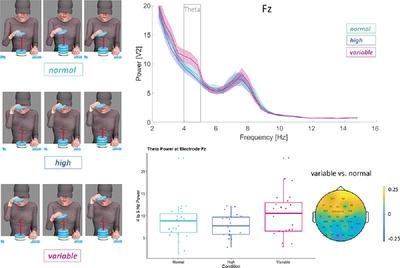Our official English website, www.x-mol.net, welcomes your
feedback! (Note: you will need to create a separate account there.)
How infant-directed actions enhance infants’ attention, learning, and exploration: Evidence from EEG and computational modeling
Developmental Science ( IF 3.1 ) Pub Date : 2022-03-27 , DOI: 10.1111/desc.13259 Marlene Meyer 1, 2 , Johanna E van Schaik 3 , Francesco Poli 1 , Sabine Hunnius 1
Developmental Science ( IF 3.1 ) Pub Date : 2022-03-27 , DOI: 10.1111/desc.13259 Marlene Meyer 1, 2 , Johanna E van Schaik 3 , Francesco Poli 1 , Sabine Hunnius 1
Affiliation

|
When teaching infants new actions, parents tend to modify their movements. Infants prefer these infant-directed actions (IDAs) over adult-directed actions and learn well from them. Yet, it remains unclear how parents’ action modulations capture infants’ attention. Typically, making movements larger than usual is thought to draw attention. Recent findings, however, suggest that parents might exploit movement variability to highlight actions. We hypothesized that variability in movement amplitude rather than higher amplitude is capturing infants’ attention during IDAs. Using EEG, we measured 15-month-olds’ brain activity while they were observing action demonstrations with normal, high, or variable amplitude movements. Infants’ theta power (4–5 Hz) in fronto-central channels was compared between conditions. Frontal theta was significantly higher, indicating stronger attentional engagement, in the variable compared to the other conditions. Computational modelling showed that infants’ frontal theta power was predicted best by how surprising each movement was. Thus, surprise induced by variability in movements rather than large movements alone engages infants’ attention during IDAs. Infants with higher theta power for variable movements were more likely to perform actions successfully and to explore objects novel in the context of the given goal. This highlights the brain mechanisms by which IDAs enhance infants’ attention, learning, and exploration.
中文翻译:

以婴儿为导向的行为如何增强婴儿的注意力、学习和探索:来自脑电图和计算模型的证据
在教婴儿新动作时,父母往往会修改他们的动作。婴儿更喜欢这些以婴儿为导向的行为 (IDA) 而不是以成人为导向的行为,并从中学习得很好。然而,尚不清楚如何父母的动作调节可以吸引婴儿的注意力。通常,人们认为使动作比平常大是为了引起注意。然而,最近的研究结果表明,父母可能会利用运动的可变性来突出动作。我们假设运动幅度的可变性而不是更高的幅度在 IDA 期间吸引了婴儿的注意力。使用脑电图,我们测量了 15 个月大的孩子在观察正常、高或可变幅度运动的动作演示时的大脑活动。在不同条件下比较婴儿在额中央通道中的 theta 功率 (4–5 Hz)。与其他条件相比,变量中的额叶θ显着更高,表明注意力参与度更高。计算模型表明,婴儿的额叶θ功率可以通过每个动作的惊人程度来最好地预测。因此,在 IDA 期间,由运动的可变性而不是单独的大运动引起的惊奇会吸引婴儿的注意力。对于可变运动具有较高 theta 功率的婴儿更有可能成功地执行动作并在给定目标的背景下探索新的物体。这突出了 IDA 增强婴儿注意力、学习和探索的大脑机制。
更新日期:2022-03-27
中文翻译:

以婴儿为导向的行为如何增强婴儿的注意力、学习和探索:来自脑电图和计算模型的证据
在教婴儿新动作时,父母往往会修改他们的动作。婴儿更喜欢这些以婴儿为导向的行为 (IDA) 而不是以成人为导向的行为,并从中学习得很好。然而,尚不清楚如何父母的动作调节可以吸引婴儿的注意力。通常,人们认为使动作比平常大是为了引起注意。然而,最近的研究结果表明,父母可能会利用运动的可变性来突出动作。我们假设运动幅度的可变性而不是更高的幅度在 IDA 期间吸引了婴儿的注意力。使用脑电图,我们测量了 15 个月大的孩子在观察正常、高或可变幅度运动的动作演示时的大脑活动。在不同条件下比较婴儿在额中央通道中的 theta 功率 (4–5 Hz)。与其他条件相比,变量中的额叶θ显着更高,表明注意力参与度更高。计算模型表明,婴儿的额叶θ功率可以通过每个动作的惊人程度来最好地预测。因此,在 IDA 期间,由运动的可变性而不是单独的大运动引起的惊奇会吸引婴儿的注意力。对于可变运动具有较高 theta 功率的婴儿更有可能成功地执行动作并在给定目标的背景下探索新的物体。这突出了 IDA 增强婴儿注意力、学习和探索的大脑机制。











































 京公网安备 11010802027423号
京公网安备 11010802027423号